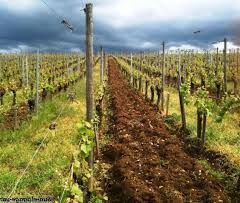Fertilizing vineyards with organic compost

Vineyard soils are particularly poor in organic matter, which is a critical weakness when facing climate change.
Bringing compost to a vineyard, associated to an improved soil management (grass bands, no-till tecnics, shredding...) should answer to more than one climatic constraint :
- increasing the soil available water capacity : an additionnal 1% carbon r
 etained in the soil could increase by 20% the amount of water available for the vine
etained in the soil could increase by 20% the amount of water available for the vine - securing the amount of nutrients available for the plant
- improving the soil structure and the vine's rooting, which means offering a better resilience to climatic hazards
- directly and indirectly retaining more carbon
- recycling organic wastes from plant and/or urban activities
- Increasing the humification index and microbial biomass
In order to conduct such improvements actions, there is a wide choice of compost types, different levels of application and burying strategies.
Author : Marc Nougier (SupAgro)
References:
http://itab.asso.fr/downloads/Fiches-techniques_viti/viti%20Amendement%20Viti.pdf
Relations
- Network
- List
- Geolocation
- More
French National Research Institute for Agriculture and Environment- INRAE
First ranking research institute in agriculture in Europe, second worldwide agricultural science provider, the INRA conducts researches concerning major society stakes.
- More
University of Nova Gorica
We are an independent, research oriented and student friendly university, where knowledge is created in a harmonious relationship between students and researchers.


